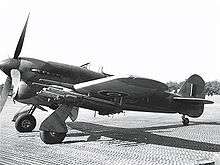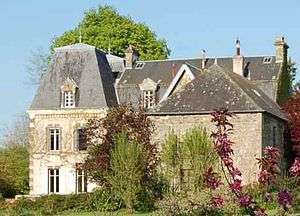RAF raid on La Caine (1944)
The RAF raid on the Panzergruppe West headquarters at La Caine in Normandy was an attack by the Second Tactical Air Force of the Royal Air Force (RAF) on 10 June 1944. The attack was made on the château at La Caine, north of Thury-Harcourt which was the base of the headquarters of Panzergruppe West, the command organisation for German armoured forces in France. Several staff officers were killed in the attack and the Panzergruppe commander, General Leo Geyr von Schweppenburg was wounded. The headquarters was withdrawn to Paris, a counter-offensive being prepared against the Allied beachhead was postponed and the headquarters command functions were taken over by the headquarters of the I SS Panzer Corps; Panzergruppe West remained non-operational until 28 June.
Attack

During the Battle of Normandy, the headquarters of Panzergruppe West was established in the château at La Caine. On 8 June, the location of the headquarters was revealed to British Intelligence by Ultra.[1][lower-alpha 1] On 10 June, aircraft of the Second Tactical Air Force (2nd TAF) bombed the village.[3] The raid was carried out by 40 rocket-armed Typhoons of 124 Wing, consisting of Nos. 181, 182 and 247 Squadrons and No. 245 Squadron of 121 Wing, that attacked in three waves from low altitude and by 61 B-25 Mitchells of 137 Wing (No. 226 Sqn) and 139 Wing, comprising Nos. 98, 180 and 320 (Dutch) Squadrons, dropping 500 lb (230 kg) bombs from 12,000 feet (3,700 m).[4]
No. 180 Squadron, headed by Wing Commander Lynn (wing leader of No. 139 Wing), led the formation, escorted by 33 Spitfires. 42 Typhoons took part in the operation, eight were fighters armed with four 20 mm cannon and the other 34 also carried RP-3 rockets (sources vary slightly on the number of aircraft on the operation). The Typhoons attacked in two waves thirty minutes apart. The first wave of 17 aircraft from Nos. 181 and 247 Squadrons, fired 136 rockets from 2,000 feet (610 m) on the parked vehicles and the château as the Mitchells accurately dropped 536 500 lb (230 kg) bombs on the target.[5]
Aftermath
Analysis
The attack destroyed the only German army organisation in the western theatre capable of handling a large number of mobile divisions; the survivors were withdrawn to Paris and not ready to resume operations until 28 June.[6][7] German command of the sector was temporarily given to SS-Obergruppenführer Sepp Dietrich and the I SS Panzer Corps.[8] An armoured counter-attack against the Allied beachhead planned for 10 June, was postponed for 24 hours and then cancelled. The appointment of new staff under General Heinrich Eberbach, delayed the plans for the German armoured counter-offensive by three weeks and the counter-attack never materialised, as it was overtaken by events. No German suspicions were aroused about Allied code breaking, because a reconnaissance aircraft had been seen before the raid.[9]
Casualties
Eighteen members of the HQ staff were known to have died in the raid, including the chief of staff Generalmajor Sigismund-Helmut von Dawans.[8][10] Schweppenburg was wounded.[11] The château was not badly damaged but the nearby orchard, in which the HQ vehicles were parked, was thoroughly bombed and communications equipment was destroyed.[8]
Notes
Footnotes
- ↑ Bennett 1979, p. 74.
- ↑ Hinsley 1994, p. 490.
- ↑ Hallion 1994, p. 18.
- ↑ Saunders 1975, p. 122.
- ↑ Terraine 1985, p. 636.
- ↑ Wilmot 1952, pp. 331–332.
- ↑ Copp 2004, p. 84.
- 1 2 3 AHB 1947.
- ↑ Bennett 1979, p. 75.
- ↑ Le Querrec 2007.
- ↑ Thompson 1956, p. 288.
References
Books
- Air Ministry (1947). The Landings in Normandy. The Liberation of North-West Europe: Operation "Overlord". III. no isbn/oclc. London: RAF Air Historical Branch Records (AIR 41/24 typed manuscript).
- Bennett, R. (2009) [1979]. Ultra in the West: The Normandy Campaign 1944–1945 (Faber Finds ed.). London: Hutchinson. ISBN 978-0-571-25374-6.
- Copp, T. (2004) [2003]. Fields of Fire: The Canadians in Normandy. Toronto: University of Toronto Press. ISBN 978-0-8020-3780-0.
- Hallion, R. (1994). D-Day 1944: Air Power Over the Normandy Beaches and Beyond. The US Army Air Forces in World War II. Air Force History and Museums Program (US). OCLC 624660056. Archived from the original on 9 May 2007. Retrieved 23 April 2007.
- Hinsley, F. H. (1994) [1993]. British Intelligence in the Second World War. Its influence on Strategy and Operations (abridged). History of the Second World War (2nd rev. ed.). London: HMSO. ISBN 978-0-11-630961-7.
- Saunders, H. St G. (1975) [1954]. Royal Air Force 1939–45: The Fight is Won. III (rev. ed.). London: HMSO. ISBN 978-0-11-771594-3.
- Terraine, J. (1998) [1985]. The Right of the Line: The Royal Air Force in the European War 1939–1945 (Wordsworth ed.). London: Hodder and Stoughton. ISBN 978-1-85326-683-6.
- Thompson, H. L. (1956). New Zealanders with the Royal Air Force: European Theatre January 1943 – May 1945. Official History of New Zealand in the Second World War 1939–45. II. Wellington, NZ: War History Branch of the Department of Internal Affairs. OCLC 270208181. Archived from the original on 23 March 2007. Retrieved 17 June 2014.
- Wilmot, C.; McDevitt, C. D. (1997) [1952]. The Struggle for Europe (Wordsworth ed.). London: Collins. ISBN 978-1-85326-677-5.
Websites
- Le Querrec, Michel (2006). "Liste des généraux morts durant la bataille de Normandie" (in French). debarquement.com. Archived from the original on 8 April 2007. Retrieved 23 April 2007.
Further reading
- Murray, W. "ULTRA: Some Thoughts on its Impact on the Second World War". Air University Review (50-2). Air Force Recurring Publication. Air University (July–August 1984). ISSN 0002-2594. Retrieved 30 September 2007.
